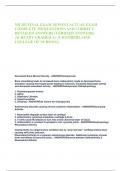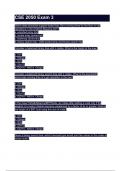NR 283 FINAL EXAM NEWEST ACTUAL EXAM
COMPLETE 250 QUESTIONS AND CORRECT
DETAILED ANSWERS (VERIFIED ANSWERS)
|ALREADY GRADED A+ (CHAMBERLAINE
COLLEGE OF NURSING)
Decreased Bone Mineral Density - ANSWEROsetoporosis
Bone remodeling leads to increased bone reabsorption, leads to decreased bone
formation causing thin fragile bones leading to fractures. Increased osteoclast activity
and decreased osteoblast activity. - ANSWEROsteoporosis Pathophysiology
1. Postmenopausal women
2. Aging
3. Sedentary Lifestyle
4. Hyperthyroidism
5. Smoking - ANSWERRisk factors for Osteoporosis
Autoimmune disorder causing chronic systemic inflammation - ANSWERRheumatoid
Arthritis
1. Neutrophils degrade surface layer of cartilage
2. Inflammatory cytokines breakdown cartilage & bone
3. T-Cells cause fibroblasts to turn into a thick abnormal layer of tissue
4. Inflammation is constant & spreads to ALL synovial joints - ANSWERPathophysiology
Rheumatoid Arthritis
Osteoarthritis is a degenerative condition due to "wear and tear" cartilage breaks down
causing stiff joints and pain.
Rheumatoid arthritis is a systemic autoimmune disorder. Additional symptoms include
fever and affects all synovial joints. - ANSWERDifference between Osteoarthritis &
Rheumatoid Arthritis
,Condition last < 3 months. Body's protective mechanism. Can be classified as somatic,
visceral, or referred. - ANSWERAcute Pain
Lasts > 6 months. Non-protective, Poorly understood. - ANSWERChronic pain
Dysfunction of the nervous system. i.e. Fibromyalgia - ANSWERNeuropathic pain
What is the treatment that increases or decreases transmission of pain signals. -
ANSWERPain management
What are the chemicals that the nervous system uses to communicate with a brain. -
ANSWERNeurotransmitters
Nociceptors receptor at the end of a sensory neuron's axon that responds to damaging
or potentially damaging stimuli by sending possible threat signals to the spinal cord and
the brain - ANSWERPain Transduction
What pain pathway signal goes to the central nervous system - ANSWERPain
transmission
Pain pathway how the brain interprets the pain signal - ANSWERPain perception
Minimum amount of stimuli that it takes for you to perceive pain. This pathway is the
same for everyone - ANSWERPain threshold
The amount of pain the body can handle before you involuntarily remove the stimuli. -
ANSWERPain tolerance
The type of pain that transmit from the peripheral nervous system to the central nervous
system - ANSWERAfferent
When the pain goes from the central nervous system to the peripheral nervous system
tell somebody how to react. - ANSWEREfferent
Chemicals released usually during exercise to prevent pain transmission signals. -
ANSWEREndorphins
What chemical reduces translation of pain. This usually happens after the
labor/childbirth - ANSWERSerotonin and GABA
This condition as a result of massive firing of neurons all at the same time. -
ANSWERSeizures
Can cause aspiration, trauma, hypoxia, hypoglycemia. - ANSWERWhy are seizures life-
threatening?
Metabolic, congenital, genetic, prenatal, trauma, infection, tumor, vascular disease,
drugs and alcohol abuse. - ANSWERWhat are typical causes of seizures?
Seizure phase where the patient experiences nausea, irritabliliy, muscle twitching, and
hours before the event. - ANSWERPreictal phase (prodromal)
, Seizure phase when the patient experiences visual or auditory sensations. Typically right
before seizure. - ANSWERPreictal Phase (Aura)
Seizure phase when the patient is actually experiencing muscle contractions, Increased
rigidity, tight jaw and loses consciousness - ANSWERIctal Phase (Tonic)
Seizure phase when the patient is experiencing muscle contractions and relaxation,
jerking type movements and increase salivation. - ANSWERIctal Phase (Clonic)
Seizure phase when the patient typically is confused, has it decreased level of
consciousness, has aching muscles and fatigued - ANSWERPostictal Phase
Condition when an occlusion forms in the brain caused by atherosclerosis. -
ANSWERIschemic Stroke (Thrombotic)
Condition when a clot forms in different part of the body and travels to the brain. -
ANSWERIschemic Stroke (Embolic)
Condition caused by a ruptured blood vessel. Usually caused by trauma, hypertension,
drugs, aneurysm or coagulation disorder. (least common) - ANSWERHemorrhagic Stroke
What is the most common cause of an embolic stroke. - ANSWERA-Fib
1. Facial Drooping
2. Arm drifts down (usually only one arm)
3. Speech is Slurred
4. Time to call 911 - ANSWERWhat is F.A.S.T
Patient may experience paralysis, sensory loss, language disorders, reflex changes,
aphasia, dysphagia - ANSWERWhat are the typical consequences of a stroke?
Syndrome of inappropriate antidiuretic hormone is increased levels of the antidiuretic
hormone. - ANSWERWhat SIADH?
What endocrine dysfunction is caused by tumor, pulmonary disorder, or surgery meds? -
ANSWERSIADH
What endocrine dysfunction causes confusion, thirst, fatigue, muscle twitching,
anorexia, nausea and vomiting. - ANSWERSIADH (Syndrom of Inappropriate Anti-
Diurectic Hormone)
Type of diabetes caused by a decreased level of antidiuretic hormone. -
ANSWERDiabetes Insipidus
Polyuremia, increased thirst, decreased blood pressure, increased osmolality,
hypernatremia, tachycardia. - ANSWERWhat are the typical symptoms of diabetes
insipidus?
Heat intolerance, weight loss, exophthalmos, thin hair, tachycardia, diarrhea, muscle
wasting, tremors - ANSWERHyperthyroid symptoms





